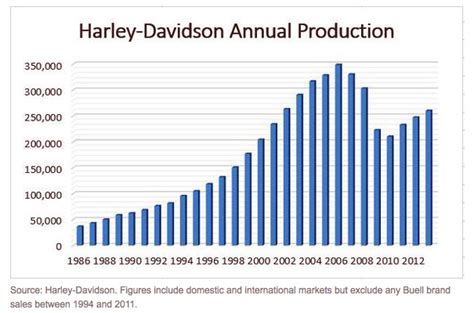
Harley-Davidson Production Numbers: A Comprehensive Overview
Harley-Davidson, an iconic American motorcycle manufacturer, has captured the hearts of riders worldwide with its distinctive design, powerful performance, and rich history. Since its inception in 1903, Harley-Davidson has experienced periods of growth, challenges, and remarkable resilience. The company's production numbers have fluctuated over the years, reflecting market conditions, economic trends, and the evolving preferences of motorcycle enthusiasts.
Early Years: Birth of an American Icon
In the early 1900s, Harley-Davidson laid the foundation for its legacy as a pioneer in the motorcycle industry. In its formative years, the company produced a limited number of motorcycles due to the nascent state of the market. However, the seeds of Harley-Davidson's future success were sown during this time, as it established a reputation for quality, innovation, and craftsmanship.
World War I: Riding into History
World War I presented a transformative moment for Harley-Davidson. The company secured government contracts to supply motorcycles to the military, resulting in a significant increase in production. These motorcycles, known for their ruggedness and reliability, played a vital role in military operations, helping to transport troops and supplies. This wartime production boost laid the groundwork for Harley-Davidson's future growth.
Roaring Twenties: A Golden Age of Motorcycling
The post-war era marked a period of unprecedented prosperity and societal change, and Harley-Davidson reveled in this newfound optimism. The company experienced a surge in production, driven by the growing popularity of motorcycles as a symbol of freedom and adventure. The Roaring Twenties saw Harley-Davidson motorcycles gracing highways and roads across the country, capturing the imagination of riders eager to explore the open road.
Great Depression: Navigating Economic Headwinds
The global economic crisis of the 1930s severely impacted Harley-Davidson, as motorcycle sales plummeted. The company's production numbers dwindled, and it faced the daunting challenge of staying afloat during these tumultuous times. However, Harley-Davidson's unwavering commitment to quality and its loyal customer base helped it weather the storm, laying the groundwork for a resurgence in the years to come.
World War II: Gearing Up for Victory
Once again, Harley-Davidson answered the call to serve during World War II. The company produced motorcycles at an astounding rate to meet the military's wartime demands. These motorcycles played a pivotal role in the Allied victory, demonstrating their durability and performance in the most challenging conditions. Harley-Davidson's wartime production efforts contributed to its long-standing reputation for unwavering resilience.
Post-War Boom: Riding the Wave of Prosperity
The post-World War II era ushered in a period of economic prosperity and optimism. Harley-Davidson capitalized on this favorable climate, experiencing a surge in production. The company expanded its model lineup and introduced iconic motorcycles like the Sportster and the Electra Glide, solidifying its position as a leading motorcycle manufacturer. This era marked a significant chapter in Harley-Davidson's growth and cemented its status as an American icon.
1970s and 1980s: Facing Market Challenges
The 1970s and 1980s presented a series of challenges for Harley-Davidson. The oil crisis and the rise of foreign motorcycle manufacturers, particularly from Japan, led to a decline in sales. Harley-Davidson found itself grappling with intense competition, forcing it to adapt and innovate to maintain its market position. Despite these hurdles, the company's unwavering dedication to its core values and its loyal customer base helped it persevere through this challenging period.
1990s and Beyond: A Resurgence of the American Icon
The 1990s marked a turning point for Harley-Davidson. The company underwent a significant restructuring, focusing on quality improvement and customer satisfaction. This strategic shift, coupled with the introduction of new models like the Dyna and the V-Rod, revitalized the brand and attracted a new generation of riders. Harley-Davidson experienced a resurgence in production, reclaiming its position as a dominant force in the motorcycle industry. This upward trajectory continued into the 21st century, with Harley-Davidson consistently introducing innovative motorcycles and expanding its global presence.
Conclusion: A Legacy of Resilience and Innovation
Harley-Davidson's production numbers over the years reflect the company's remarkable journey, marked by periods of growth, challenges, and unwavering resilience. From its humble beginnings to its status as an American icon, Harley-Davidson has consistently demonstrated its ability to adapt to changing market conditions, innovate to meet evolving rider preferences, and overcome adversity. The company's commitment to quality, craftsmanship, and the unique Harley-Davidson riding experience has ensured its enduring appeal and secured its place in the annals of motorcycle history.